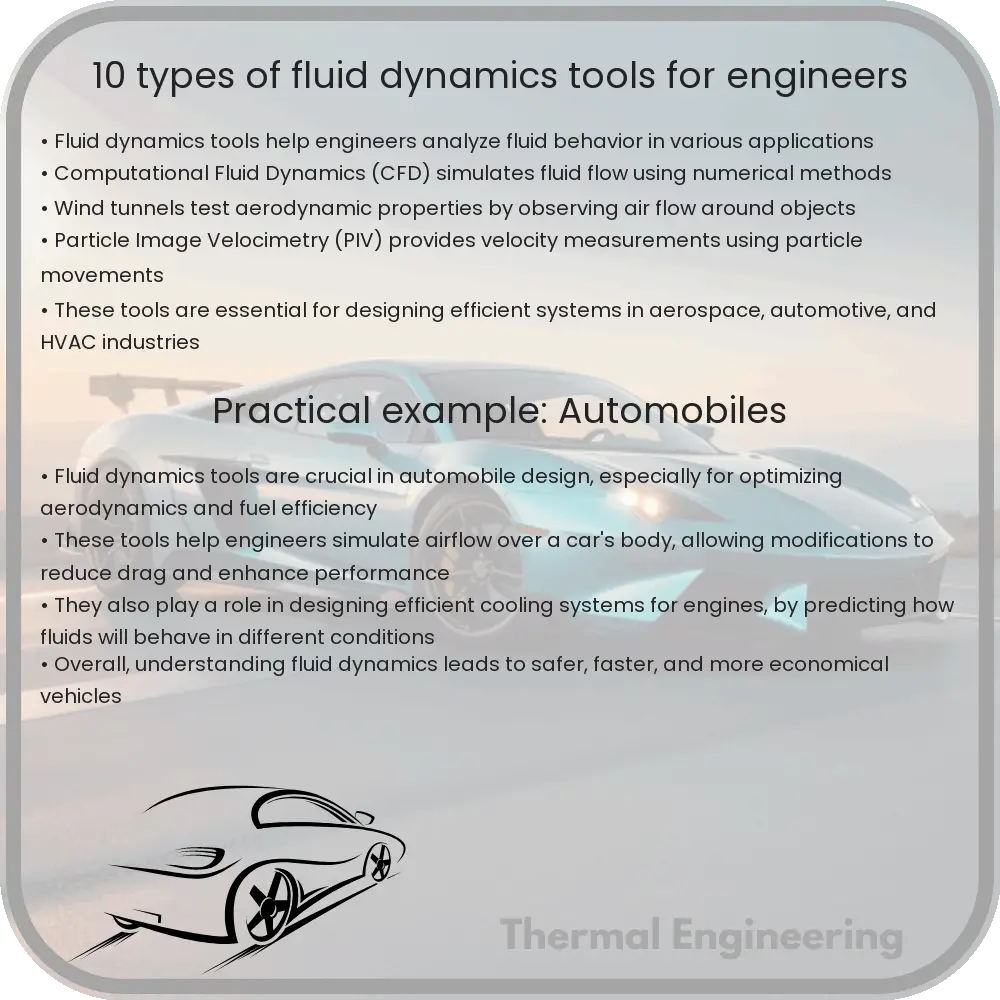Explore essential fluid dynamics tools used by engineers in various fields to analyze and solve fluid-related problems efficiently.

10 Types of Fluid Dynamics Tools for Engineers
Fluid dynamics plays a critical role in engineering, influencing fields such as aerospace, automotive, civil, and chemical engineering. This branch of physics deals with the study of fluids (liquids, gases, and plasmas) and the forces acting on them. Engineers use a variety of tools to analyze and solve fluid dynamics problems. Here’s a list of 10 essential types of fluid dynamics tools that engineers commonly utilize:
1. Computational Fluid Dynamics (CFD) Software
CFD software is used to simulate fluid motion and heat transfer. This tool uses numerical methods and algorithms to solve and analyze problems that involve fluid flows. Examples of popular CFD software include ANSYS Fluent, COMSOL Multiphysics, and OpenFOAM.
2. Wind Tunnels
Wind tunnels are used to test the aerodynamics of objects. By moving air past an object fixed in the tunnel, engineers can study the flow of air and its effects, which is crucial in the design of aircraft, automobiles, and buildings.
3. Particle Image Velocimetry (PIV)
PIV is an optical measurement technique to visualize and analyze fluid flow. It uses laser light to illuminate particles seeded in the fluid and captures their movement over time with cameras, which helps to map velocity fields.
4. Laser Doppler Anemometry (LDA)
LDA is a technique used to measure the velocity of a fluid at a specific point. It works by detecting frequency shifts from laser light scattered by particles moving with the fluid, providing accurate, non-intrusive velocity data.
5. Hot-Wire Anemometers
Often used in wind tunnel testing and HVAC applications, hot-wire anemometers measure fluid velocity based on heat loss from a wire heated up to a constant temperature, which is proportional to the speed of the airflow.
6. Pitot Tubes
Pitot tubes are simple devices used to measure fluid flow velocity. The device is inserted into the flow and uses the difference in pressure from moving fluid to calculate the velocity based on Bernoulli’s principle.
7. Flow Visualization Techniques
Flow visualization includes methods like smoke or dye streams, which help engineers qualitatively understand fluid flow patterns. These techniques are especially useful in complex flows where detailed visual observations are necessary.
8. Pressure Transducers
Pressure transducers are used to measure fluid pressure within a system. They convert pressure into an electrical signal and are essential for monitoring and controlling fluid systems in industries.
9. Rheometers
Rheometers are instruments used to measure the properties of fluids that have complex flow characteristics, like non-Newtonian fluids. They are crucial in industries where understanding the fluid’s viscosity is essential for processing and quality control.
10. Flow Meters
Flow meters are used to measure the flow rate or quantity of a gas or liquid moving through a pipe. There are many types of flow meters, including volumetric flow meters and mass flow meters, each suitable for different applications.
Understanding and utilizing these tools allows engineers to innovate and optimize designs across various fields, ensuring efficiency, safety, and performance in fluid-related technologies.